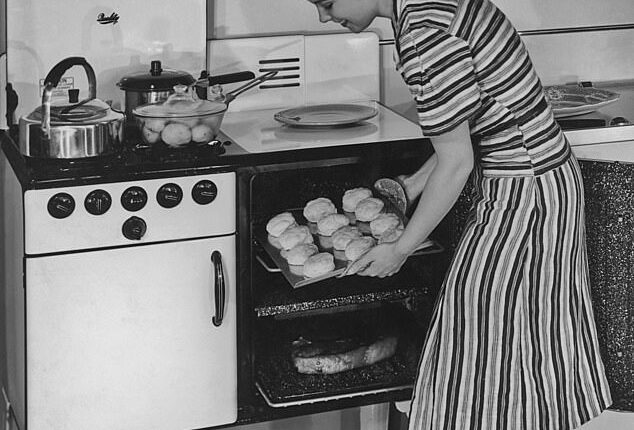While Gen Z and Millennials in Britain have become accustomed to eating trendy acai bowls in the name of good health, or even resorting to weight loss jabs, experts say that a simple wartime diet could in fact the key to losing weight.
A 1940s ration diet can ‘naturally support weight loss’ unlike highly processed ‘modern day diets’, according to medical experts.
Swapping a culture of takeaways and mindless snacking for bread, baked beans, minced meat and tinned fruit is beneficial for gut health because they are ‘great sources of fibre, vitamins and minerals’.
After World War II was declared in September 1939, the British government had to cut down on the amount of food it shipped in from other countries, as German submarines started targeting supply ships.
This meant that each citizen was limited to a certain amount of milk, eggs, butter, sugar, tea and meat every week – including only having one fresh egg. Cupboard essentials did not gather dust as they do today, but were instead depended on by millions of struggling families.
One woman recently followed the basic diet for eight days and was shocked after she shed 5Ibs and felt more energetic, completely transforming the way she saw food.
Mounjaro costs around £30 a week for the highest dose, but those paying privately could see that price shoot up to £82 after manufacturer Eli Lilly said it was increasing prices by as much as 170 per cent. However, the cheap retro groceries will set you back around £15.26 a week.
Nutritional therapist Deborah Grayson, who runs Digestion With Confidence, said the wartime diet is healthy because it limits ‘high-calorie, low-nutrient foods’ and therefore eases people into a calorie deficit.

After World War II was declared in September 1939, the British government had to cut down on the amount of food it shipped in from other countries. Pictured: A woman baking bread in the 1940s

Dishes such as cottage pie and shepherd’s pie (pictured) were cooked often due to the rations (stock image)

Baked beans on toast were also eaten by many families during the days of World War II (stock image)
She told the Daily Mail: [It] focuses on structured, three-meal-a-day eating. With minimal snacking and desserts only at the weekend, it encourages a gentle calorie deficit without feeling restrictive.
‘Unlike modern diets, which are often high in processed foods, added sugars and frequent snacking, the wartime diet relied on fresh, seasonal ingredients prepared from scratch.
‘Meals were simple, filling and based around vegetables, legumes and whole grains – foods that naturally promote satiety and stable energy levels.’
Deborah said that the 1940s style of eating is ‘excellent for heart health, digestive function and long-term wellbeing’.
She said that beans, porridge and vegetables are high in fibre and supports gut health and the low intake of saturated fat and sugar reduces the risk of obesity and metabolic disease.
She added: ‘We could all benefit from adopting some wartime principles today – cooking at home, eating whole foods, limiting snacks and focusing on fibre-rich meals.
‘That said, we would need to make small adjustments to meet modern nutritional needs, such as including more fruit, oily fish and vitamin D sources, which is tricky to achieve from food alone, so ensure regular exposure to daylight.’
Deborah said that while the wartime diet has many strengths, it is not entirely perfect.

Bubble and squeak, fried cabbage with potatoes and meat, was also seen as a staple dish

Those who lived throughout the 1940s would often eat porridge several times a week (stock imae)

In the 1940s, families would cook at home more and were not exposed to as many ultra-processed foods as today, according to health experts
Fruit and certain nutrients like calcium and omega-3 fatty acids were limited, and protein variety was lower than we recommend today,’ she said. ‘Anyone trying this style of eating now should ensure they’re getting a full spectrum of vitamins and minerals.’
She said that planning meals, eating whole foods, cooking with basic ingredients and resisting the urge to snack are ‘just as relevant for health and weight management today as they were 75 years ago’.
Throughout the 1940s, Brits relied on recipes such as Woolton pie, which typically had a filling of cauliflower, parsnips, carrots and onions – because of the limitation on meat. They made use of all of their limited ingredients by using leftovers to create bubble and squeak, which is cooked cabbage fried with potatoes and often leftover meat.
Poor Knights Fritters, also known as French toast, was also eaten during the wartime as it was made up of less than five ingredients – stale bread, milk, sugar and sometimes jam.
Registered menopause nutritionist Karen said that pulses put into stews with cabbage are ‘great sources of fibre, vitamins and minerals’.
She said: ‘Leftovers for lunch are great and are something I advocate for. No sad sandwiches or meal deals as they won’t give you the sustenance that leftover cottage pie and peas would.
‘No processed food is important as eating ultra-processed food can often lead to overeating and insulin resistance, which are both common reasons for weight gain.’
Karen said that we are ‘so spoilt’ with food choices in the 21st century, as we have a range of fruits, vegetables and meats available to us throughout the year.
‘Back then it would have been very seasonal’ she said. ‘Although seasonal food often tastes better because it has just been picked, our dopamine receptors also like variety.’
During World War II, each person was limited to approximately 57g of butter, 113g of margarine, 57g of lard, two pints of milk, one fresh egg, 57g of bacon, 227g of sugar, 57g of tea and around 450g of meat.
Sweets were seen as a luxury, with Brits receiving a 350g packet every four weeks.
Dr Emily Leeming, dietician and the author of Genius Gut, said that those living through World War II did a ‘good job of making the most of simple, affordable staples’.

A woman is pictured holding a glass bottle full of conserved fruits in the 1940s, during the ration era

The lack of meat means families would also eat more vegetable based dishes, such as stews and soups (stock image)

Woolton pie typically had a filling of cauliflower, parsnips, carrots and onions – because of the limitation on meat (stock image)
She said: ‘It’s built around beans, oats and vegetables, so while it would probably still fall short of today’s 30g a day fibre target, it’s almost certainly higher in fibre than the average modern diet.
‘It’s also noticeably free of many of the ultra-processed foods that dominate today’s diets, instead the convenience is from making use of leftovers instead.’
However, Emily agrees that it would not fully meet the expectations of a balanced diet now.
‘The protein is a little low, there’s no oily fish to provide omega-3, and very little dairy or fruit, meaning key nutrients like calcium and certain vitamins are missing.
‘If you were to modernise this plan, you’d add one to two portions of fish each week, a wider range of fruits and vegetables, some dairy, and more protein from foods like eggs, lentils, chicken, fish, nuts and seeds.’
Louise Carter, a dietician and wellness expert, said that the calorie restriction and reduced intake of sugar and processed foods would encourage weight loss.
She said: ‘Today’s way of eating – while we have more variety of foods, is full of convenience and really large portions. Foods are higher in added sugars, preservatives, fats and refined carbohydrates whereas the 1940’s diet was naturally lower in these.
‘Portion sizes were also smaller, and meals were often based around simple vegetables and whole grains, with less focus on protein and dairy.

A woman is seen baking bread in her kitchen in 1945, the year the war ended
‘Elements of the 1940’s way of eating could definitely benefit us today. I am always encouraging people to cook more at home, eat more whole foods, and limit processed snacks. Understanding how meals are made and balancing them is key.’
However, Louise felt as though wartime meals lacked protein which is ‘an important part of wellness and should not be neglected’.
She added: ‘Our sedentary lifestyles also mean we do not need as many carbohydrates.’
Belle Amatt, a nutritionist at W-Wellness, said the 1940s diet would be good for those who are prone to snacking or consuming more calories than they expend.
‘The wartime food plan emphasises limited portions, whole foods, and structured meals. This style of eating, rooted in wartime scarcity, prioritises simple ingredients like root vegetables, modest protein, and very little sugar or fat.
‘Unlike today’s ultra-processed, convenience-driven diets, it reduces overeating and encourages mindfulness around food. While it lacks some fibre and variety, it promotes a more intentional, sustainable approach to eating that many could benefit from today.
‘A more ideal approach may be blending the structured, mindful eating patterns of the 1940s with the well-researched Mediterranean or Blue Zones diets, which are rich in variety, plant-based foods, and long-term health benefits.’








